I frequently use kernel density plots to illustrate distributions. These are easy and fast to create in R like so:
set.seed(1) draws <- rnorm(100)^2 dens <- density(draws) plot(dens) #or in one line like this: plot(density(rnorm(100)^2)) Which gives me this nice little PDF:

I'd like to shade the area under the PDF from the 75th to 95th percentiles. It's easy to calculate the points using the quantile function:
q75 <- quantile(draws, .75) q95 <- quantile(draws, .95) But how do I shade the the area between q75 and q95?
The vertical or y-axis of a KDE plot represents the Kernel Density Estimate of the Probability Density Function of a random variable, which is interpreted as a probability differential. The probability of a value being between the points x1 and x2 is the total shaded area of the curve under the two points.
A density plot is a representation of the distribution of a numeric variable. It uses a kernel density estimate to show the probability density function of the variable (see more). It is a smoothed version of the histogram and is used in the same concept.
With the polygon() function, see its help page and I believe we had similar questions here too.
You need to find the index of the quantile values to get the actual (x,y) pairs.
Edit: Here you go:
x1 <- min(which(dens$x >= q75)) x2 <- max(which(dens$x < q95)) with(dens, polygon(x=c(x[c(x1,x1:x2,x2)]), y= c(0, y[x1:x2], 0), col="gray")) Output (added by JDL)

Another solution:
dd <- with(dens,data.frame(x,y)) library(ggplot2) qplot(x,y,data=dd,geom="line")+ geom_ribbon(data=subset(dd,x>q75 & x<q95),aes(ymax=y),ymin=0, fill="red",colour=NA,alpha=0.5) Result:

If you love us? You can donate to us via Paypal or buy me a coffee so we can maintain and grow! Thank you!
Donate Us With